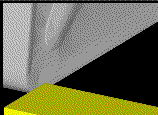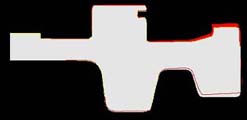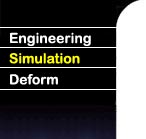|
Computer simulation of manufacturing processes:
This technology provides the possibility to calculate and optimise the workpiece and
tool
behaviour during a production cycle.
Our simulation models calculate the complete manufacturing process of metallic components.
Starting from the prematerial all required operations, such as forming, heat treatment
and
machining cycles can be included. The properties of the workpiece and the behaviour
of the
tools are calculated and can be analysed on the computer.
Under consideration of all technical and technological aspects we achieve a non-stop
development process on a virtual prototype. This is a very efficient way to develop
and
optimise the product properties and manufacturing technology including case-studies.
Aim of these analysis is:
|
| |
 efficient development of technology efficient development of technology
 reduced production costs by minimizing manufacturing defects reduced production costs by minimizing manufacturing defects
 increase of production rates increase of production rates
 shortening of the lead-time shortening of the lead-time
 improved quality of products and manufacturing processes improved quality of products and manufacturing processes
 reduced costs for tooling reduced costs for tooling
 optimisation of the product cycle optimisation of the product cycle
|
|
| |
|
Further information on:
|
|
|
| |
| |
Forming simulation:
On the bases of the software DEFORMTM , realistic simulation models make the
calculation of the most important manufacturing techniques in metal forming possible.
In these models the relevant data for the workpiece, the material, the tooling and the
process are included.
Considering the influence of the environment, the characteristic of the press, the
workpiece-tooling interface, the material flow and the temperature field the production
process is calculated.
We have successfully run several projects in the technologies of cold and hot forming
listed below:
|
| |
| |
 Sheet and shape rolling Sheet and shape rolling
 Forging Forging
 Wire drawing Wire drawing
 Extrusion Extrusion
 Deep drawing Deep drawing
 Hydraulic forming Hydraulic forming
 Compacting of porous material Compacting of porous material
 Induction heating Induction heating
|
|
 |
 |
 |
|
| |
Heat Treatment simulation:
In cooperation with partners we have explored further features of DEFORMTM
to develop simulation models for several heat treatment cycles on steels
and non-ferrous alloys.
Typical quenching in water, oil, air and furnace can be analysed.
In addition different heating methods are included.
The simulation models consider:
|
| |
| |
 Diffusion type and martensitic phase transformation Diffusion type and martensitic phase transformation
 Microstructure evolution with recrystallisation and grain growth Microstructure evolution with recrystallisation and grain growth
 Carburisation Carburisation
 Residual stress and distortion Residual stress and distortion
 Hardness prediction Hardness prediction
 Risk of quench cracking Risk of quench cracking
|
|
| |
Machining:
With these newest routines we have models for the analysis of material removal.
The routines are capable of simulating the workpiece and tool behaviour, as well as
the interface between them. |
| |
|
In micro-simulation we calculate:
|
| |
| |
 Cutting forces
Cutting forces |
 Contact temperatures
Contact temperatures |
 Stresses
Stresses |
 Wear rates
Wear rates |
|

|
|
|
Macro-simulation supplies us with information on:
|
| |
| |
 Machining distortion
Machining distortion |
 Residual stresses
Residual stresses |
|

|
| |
|
|
|
| |
| |
| |
|
Advantages of the computer simulation:
|
| |
| |
 Elimination of expensive and time-consuming prototype development Elimination of expensive and time-consuming prototype development
 Shortening of "time to market" Shortening of "time to market"
 Quality improvement through a better understanding of the detailed process Quality improvement through a better understanding of the detailed process
characteristic
 Higher production rates through optimisation Higher production rates through optimisation
 Reduced production costs by eliminating potential operating problems Reduced production costs by eliminating potential operating problems
 Higher level of customer confidents Higher level of customer confidents
|
|
With the computer simulation we get a comprehensive inside into the component and
a detailed understanding of each production step.
By variation of the parameters each process step can be analysed to determine the
process limit and the measures to be taken to ensure the quality.
This knowledge enables you to refine your state of technology and enrich the product
properties in order to precisely meet the requirements.

|



